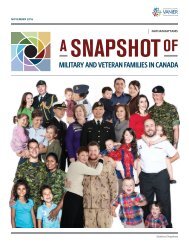1ee0ey1
1ee0ey1
1ee0ey1
You also want an ePaper? Increase the reach of your titles
YUMPU automatically turns print PDFs into web optimized ePapers that Google loves.
A HOMELESS HUB RESEARCH PAPER<br />
trying to make a life in cities. These barriers can be viewed as the continuation of centuries of cultural<br />
oppression. Aboriginal Peoples also disproportionately suffer from personal disabilities (physical and mental<br />
health status, substance abuse) and the effects of interpersonal violence and racism (Peters 2012, Adelson<br />
2005). All of these factors put them at a significant disadvantage in the employment and housing markets.<br />
When combined with the potential loss of social support networks this increases their likelihood of becoming<br />
homeless when moving from reserve to city. However, the urban Aboriginal homelessness crisis is very much<br />
a ‘macro’ issue – that is, it emerges from distinct historical processes, structural causes (cultural, economical),<br />
political decisions and neglect. These topics are discussed throughout the review.<br />
Another factor to consider is the ability of Aboriginal Peoples to secure adequate housing in cities – either<br />
as renters or owners. Recent research indicates that, “at a national level, urban Aboriginal homeownership<br />
and rental rates are lower than those of mainstream Canada, and Aboriginal Peoples tend to present higher<br />
core housing needs 6 and lower income levels” (Belanger et al. 2012 a:17). The literature on this topic reveals<br />
that Aboriginal Peoples may face economic discrimination in securing adequate and affordable housing. As<br />
Walker (2003) points out, the selection processes that include credit history checks to access rent-to-own<br />
housing may exclude many Aboriginal Peoples who often lack any credit history.<br />
The following chart illustrates Aboriginal Peoples’ over-representation in urban homeless populations:<br />
6. The Canada Mortgage and Housing Corporation considers a household to be in core housing need if “its housing falls below at<br />
least one of the adequacy, affordability or suitability, standards and it would have to spend 30% or more of its total before-tax<br />
income to pay the median rent of alternative local housing that is acceptable” (CMHC 2010:np). For housing to be considered<br />
adequate, it must not require any major repairs, according to residents. For housing to be considered affordable, it must cost less<br />
than 30% of the total before-tax household income. For housing to be considered suitable, it must contain enough bedrooms for<br />
the size and make-up of its residents (CMHC 2010).<br />
19





